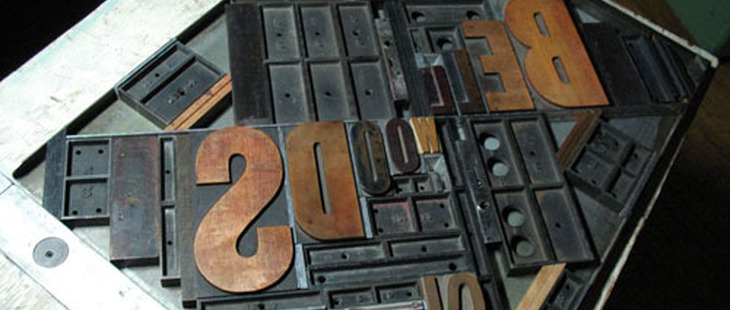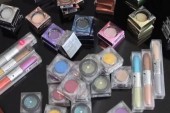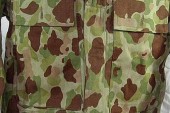
 Nicholas Kennedy at Trip Print Press (EWL)
Nicholas Kennedy at Trip Print Press (EWL)
In a hyper-consumerist, hyper-digitized world, letterpress printing continues to enjoy a revival. Seen in everything from handmade wedding invites to one-of-a-kind artists’ books, the craft’s tactile nature, unabashed authenticity and artisanal quality is a welcome antidote to the slick, computer-generated graphics that bombard us every day. Here, The Standard visits some of Toronto’s leading letterpress lights.
 Deborah Barnett and Aaron Benson at Someone (EWL)
Deborah Barnett and Aaron Benson at Someone (EWL)
The Boutique Print Shop
Someone, on Dundas Street West, opened its doors earlier in January, quickly establishing itself as a new kind of design studio that merged brand tradition with traditional letterpress printing equipment. Aaron Benson and Deborah Barnett have over 30 years experience in the graphics business, Benson as an all-round printing and web design expert (he’s worked at Coach House Books, among others) and Barnett as a creative director, business developer and artist. Their decision to open a storefront, and put a retail face on the traditional art of letterpress, came out of a desire to de-mystifty — and put the fun and some of the handcrafted beauty — back into printed communications. “Over the past decade, offset digital printing has become so advanced and precise,” Barnett says, “that it’s absolutely perfect. After a while, perfection becomes boring and impersonal. Clients today want something with presence and a human touch in the work.” Using old equipment — some pieces of machinery are 100 hundred years old — the studio produces a wide range of exclusive products, from books to business cards.
In the back of the shop, Benson is making a small run of “Back in 5” window signs on an ancient manual flatbed press. He deliberately chooses each letter of wooden block type and a metal engraved image, and arranges the pieces in the frame with care. Then, using a spatula, he spreads out a dollop of thick red printer’s ink and, with the aid of the manual press and with every strike, the raised design is transferred beautifully to sheets of pollen-yellow card stock. If the design were faked on a computer it would look cheap and awkward. Here the patina of the type and the way the ink has sunk into the card stock makes it unique, even precious. “Traditional tools like letterpress and handset typography help people communicate more abundantly and creatively,” says Benson.
In today’s marketplace, Barnett argues, it makes better sense to create a product that will be more meaningful to clients. “Times have changed. It’s not what you know, it’s not even who you know. It’s how well they know you. Letterpress offers something that’s tactile and honest.”
The Workshop
While Someone will be starting one- or two-person instructional classes later this year, the Bookhou design studio, further east along Dundas, has been a popular spot for letterpress workshops since 2002. Run by the husband-and-wife team John Booth and Arounna Khounnoraj, the studio is a showcase for their numerous creative talents in furniture design, textiles and decorative arts. Khounnoraj’s arts degree background is in printmaking and letterpress so it was an obvious decision to offer workshops in those particular skills. Workshop participants are taught to produce unique designs on fabric, wood, leather and organic recycled cotton.
The workshops are offered to only a few participants at a time, ensuring that everyone gets adequate attention. They mainly attract twenty and thirtysomethings, many of whom are either graphic designers who wish to experiment with an art form that’s not digital or artists who want to design and print their own materials. “Using old technology is very satisfying to many people these days,” explains Khounnoraj. “Many of those who sign up for our workshops are looking to explore and experiment with the medium and produce a range of materials, be it their own small book, wedding invitations or business cards. Everyone comes away satisfied.”
The Big(ish) Studio
Lunar Caustic Press is one of the premium letterpress studios in the city, and operates a downtown studio in the former garment district managed by master printer Neil Wismayer. A number of weighty piston-driven mechanical presses, manufactured by Heidelberg, occupy the 2,500-square-foot studio. The sights and sound of hissing pistons, cogs, levers and shifting paper is marvelous to behold, the oldest press the same age — 77 — as the mechanic who services it. (He’s the last factory press technician alive in North America, perhaps even Europe.)
Wismayer, who’s been a printer for more than 20 years, explains that the modern mechanical letterpress would be largely defunct today if it were not for the developments in the 80s that allowed the re-engineering of the technology. Now, digital files can be transferred to film and then to flexible plastic printing plates — a far more economical and accessible process. This was the main catalyst that allowed smaller firms to open in the early 90s, encouraging them to compete in the commercial market place without the having to compose everything by hand. Since then, Lunar Caustic has produced a ream of various materials in styles ranging from the artistic and experimental to traditional high-end gold foil embossed business cards, full stationery kits, wedding invites, books and posters.
The Traditionalist
Nicholas Kennedy, owner of Trip Print Press, is one of the few remaining commercial craftsmen in Toronto who still makes and uses his own lead type, a technique originally invented for newsprint. Still only in his twenties, Kennedy is part of a new generation of print craftsman. Inspired by an article in, of all places, Martha Stewart Living, he took a summer class at OCADU and then spent some time in the Ryerson library boning up on the art form. He opened his own print shop four years ago in a bright top floor unit on Wallace Avenue.
A couple of years ago Kennedy bought a 70s-era Heidelberg mechanical letterpress so he could compete better for commercial printing contracts (more volume, quicker turnaround). He still, however, begrudges its mechanics every time the starter motor fails. “Metal and wood handset type has been relegated to posters, broadsides, personalized stationery and bookbinding,” Kennedy says. “But it’s a very smart and clever process, far easier to update and change than a design transferred to a plate.”
The machine that casts lead and tin type, in sizes from 4 to 144 point, was made in the 50s and is still going strong. It has the advantage of being a closed loop machine that creates a reusable product and no waste: it simply recasts old type to create new. The type, or “slugs,” are then loaded on to a composite stick which aligns every row of type and allows you to arrange the type in any arrangement. Kennedy tells me that in the United States there’s a growing number of lead type enthusiasts who manage to make a living operating out of their garages or basements (or at least try to make a living).
While the demand for such boutique or couture printing is somewhat smaller in Canada, Toronto is nonetheless an international centre of refurbished letterpress equipment. Don Black Linecasting in Scarborough, is according to Kennedy, an Ali Baba’s cave of letterpress equipment and contains probably the best and most organized inventory in the world. With a background in the newspaper printing industry, Black started to buy up equipment that had been cast aside with the advent of offset printing. Through Kennedy’s close relationship with Black, he has been able to meet and learn from a number of elderly retired printers, which he describes as “a fantastic brain trust.”
Handset wood and metal type can cost more than digital production, but this is generally because of the amount of consultation with a client. The more proofs required, and the more debate over the final design, the pricier it becomes. Kennedy, of course, thinks such effort is well worth it: “Letterpress has an artistic quality that modern digital printing just can’t emulate. It’s like a pair of jeans that you’ve worn in yourself over time that says something about you, versus a pair that has been faked to look antique.”
















